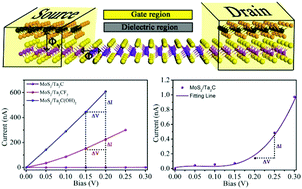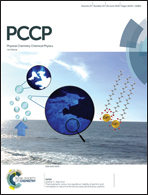Modified MXene: promising electrode materials for constructing Ohmic contacts with MoS2 for electronic device applications†
Abstract
The development of MoS2-based electronic devices is dependent on finding electrode materials suitable for forming Ohmic contacts with MoS2. For this purpose, we carried out density functional theory and nonequilibrium Green's function calculations to investigate the possibility of using pristine and modified MXene (Ta2C/Ta2CF2/Ta2C(OH)2) monolayers as the electrode materials in such devices. These calculations indicated the formation of chemical bonds at the MoS2/Ta2C interface, and resulting strong orbital hybridization between the MoS2 and Ta2C components, but relatively weak interactions for MoS2/Ta2CF2 and MoS2/Ta2C(OH)2. Ohmic contacts were observed in all three cases. Transport properties were further simulated by modeling two-probe field effect transistors (FETs) with Ta2C/Ta2CF2/Ta2C(OH)2 as electrodes. Interestingly, these simulations indicated the formation of Ohmic contacts between Ta2CF2/Ta2C(OH)2 electrodes and the channel, but an n-type Schottky barrier for the Ta2C electrode. Furthermore, we found the resistance of the FET based on MoS2/Ta2C(OH)2 to be half of that based on MoS2/Ta2CF2. The results of our study not only revealed promising electrode materials for forming full Ohmic contacts with MoS2 monolayers in FET devices, but also validated the effective role of a small-molecule fragment as a buffer layer in realizing Ohmic contacts between metal and semiconductor.



 Please wait while we load your content...
Please wait while we load your content...